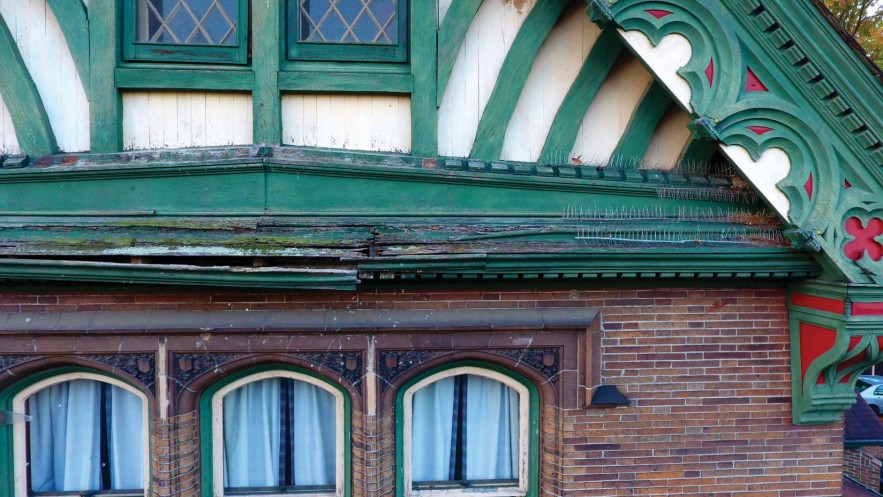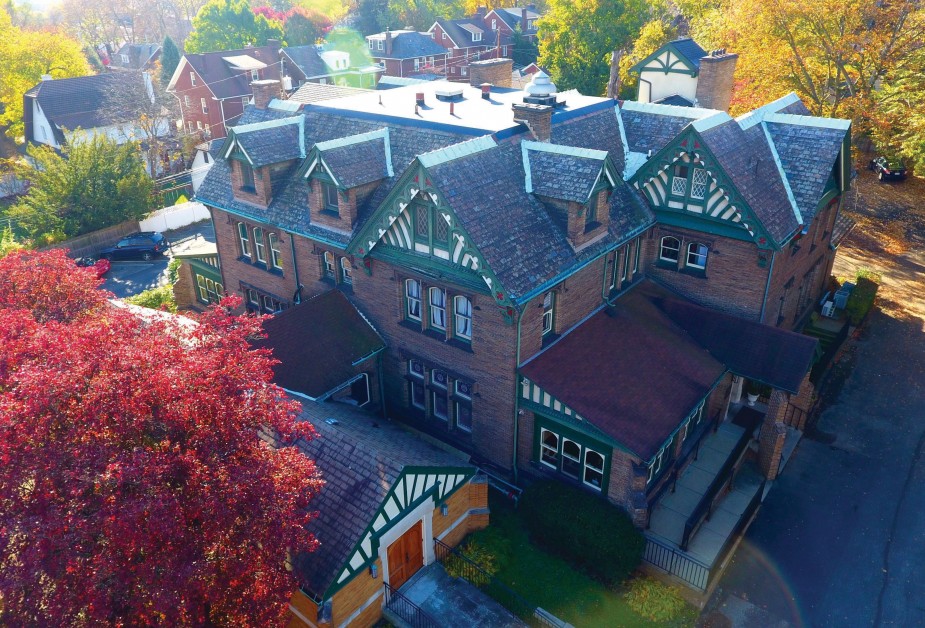You have free articles remaining this month.
Subscribe to the RP Witness for full access to new articles and the complete archives.
Homes come in many sizes and shapes. They protect us from the elements and are the places of great moments and memories of family life. Your home is likely a sanctuary of peace: it is a place where you can feel at ease and comfortable.
Since 1923 the building known as The Gables has been home for the Reformed Presbyterian Theological Seminary. Locals identified the structure by its various gable ends, which were quite common in Europe at that time. The former home of Durbin Horne of Horne’s Department Stores, a Western Pennsylvania institution for generations of Pittsburghers, The Gables was a famous landmark in Pittsburgh’s East End, along with the homes of many industrialists, such as George Westinghouse, Andrew Carnegie, and Henry Clay Frick.
With amazing foresight, the Reformed Presbyterian Church of North America chose this elegant and well-built edifice to house its seminary. Several major renovations have taken place through the years. In 1961 a chapel was added to the building. Retired professor Dr. Wayne Spear once reflected to a class that he had worked on his car’s transmission in the area that is now the chapel. In 1970 a two-story library annex was added. Further work commemorating the seminary’s 175th anniversary in 1985 saw the addition of the Rare Books Room, and more renovations added classroom and office space in 1999. The last major work on campus was in 2008 when the Willson Center, across Penn Avenue from the main building, was purchased and refurbished to provide space for the growing biblical counseling program and for student housing.
The structure of The Gables, now called Rutherford Hall, is amazing. Architecturally, the building is quite stunning, with delicate and visually pleasing rooflines and gables. Beneath the beautiful exterior is an incredibly strong foundation and durable, stout framing. In some places, the outer walls are several feet thick. The framework inside the walls consists of handmade, pieced timbers of great strength. The wise man in Matthew 7 is told to build his house on the solid rock of the Lord. RPTS does so both theologically and with its building, providing a solid foundation on all fronts.
All of this is why it makes good sense to remodel and restore the building rather than building anew somewhere else; it is plain, good stewardship. To that end, the seminary board of trustees decided to launch a $3 million capital campaign, “Save the Gables.” The campaign is intended to extend through June 2018 to correspond with Jerry O’Neill’s retirement as president of the seminary. Goals include the restoration and renovation of the original roof, the gables, and the kitchen and basement areas.
Here are some of the details of the plan:
The Gables
Intricately and artistically constructed architectural features along the roofline of the building, the gables have given this building its historic name. Hand carved and assembled, these decorative pieces are wonderful examples of the skilled craftsmanship that has gone into every nook and cranny of the building. In the summer of 2015, some restorative work was planned on one of the gables, and it was discovered that the gables were seriously deteriorating and in need of extensive restoration.
Moldings such as those used in the original construction of the building are no longer available. You do not simply walk into your favorite do-it-yourself store and find replacement materials. Working with a well-known and skilled mill in Pittsburgh, a plan was devised to reconstruct the gables by utilizing modern composite materials that would exceed the lifespan of the original wood. These intricate pieces are cut by computer and assembled in multiple layers for installation. With fresh paint on a regular basis, these new gable ends should last over 100 years. The tooling and computer process also helps to minimize the overall expense.
The Roof
Installed in the late 1890s, the original slate roof has protected the building from Pittsburgh’s rain, snow, and ice for about 120 years with only a few minor repairs needed. Still in decent shape, the roof is reaching the end of its useful lifespan. Replacing the roof now, before significant damage and leaking occurs, is good stewardship as the expense of repairing further damage is prevented. The replacement for the roof is slate, which should last another 125 to 150 years. New gutters and valleys will be installed along with an upgrade to the over 40-year-old flat roof covering the library annex.
The Kitchen
Just like your home, the kitchen at RPTS is one of the major hubs of fellowship. Students linger over cups of coffee as the professors speak of their real-life experiences in ministry, expand upon classroom lectures, and show how theological concepts come to life in the real world of the local church. Located in the basement, the kitchen is quite dated, having served the seminary community faithfully for many decades. For instance, the ovens run far below their temperature settings, requiring extra time in cooking. Counter and storage space is inadequate. The makeshift dishwasher needs to be replaced.
As a meeting place, the placement of the basement walls hinders a large gathering of students in one place to fellowship. Divided into three separate areas, a rearranging of walls would allow for better use of the space, especially for large gatherings such as FEAST (Friends Eating At Seminary Tables), a regular gathering of students, faculty, and staff for an evening meal. A redesigned multi-purpose room would provide flexibility for ministry. The evangelism class hosts an Andrew Dinner in the spring where the community is invited to share in a dinner and hear a gospel presentation by one of the professors. In nice weather, this meal is held on the front lawn of the seminary with students inviting passersby to join in the group. Inclement weather limits the ability to comfortably seat guests in the basement area.
The Theological Foundations for Youth (TFY) group heavily utilizes the seminary facility for two weeks every summer. Approximately 50 people gather for breakfast, lunch, and dinner in this tight space. Frankly, this area is sterile, dark, and uninviting; the opposite of what most of us desire for our own kitchens and dining areas. Yet, the glow of friendship helps to overcome the inadequate lighting and tight physical quarters. Renovation will help to overcome these challenges.
The Endowment
Each year, it is necessary to pay for unexpected repairs on the main building and on the seven seminary-owned apartments and houses. Hot water heaters, sewer replacements, electrical upgrades, and more are common examples of such repairs. The seminary owns the seven housing units to provide inexpensive apartments for students who traditionally do not have large amounts of money available for rent. These facilities are adequate, but older, and bring with them the struggles of aging homes. When these expenses occur, the annual budget is used, which means that other important items are not purchased or updated. It becomes a vicious cycle of always being behind in maintenance and repairs. An endowment would provide a yearly source of funding for these and other repairs.
Each of the above areas, along with the normal budget of the seminary for a year and a half, totals $3 million. As of Oct. 16, 2017, $1.6 million has been raised toward that end. More details, including videos and photos, are available on the seminary’s web site, www.rpts.edu.
RPTS president, Dr. Jerry O’Neill, notes, “The Save the Gables campaign is important only because of what is housed therein. The main thing is the mission of the seminary to train future pastors and others for effective service in Christ’s kingdom.” Michael LeFebvre, president of the Board of Trustees, ponders, “If walls could talk, it would be remarkable to review the countless hours of instruction heard by these rooms.”
Stop by for a visit and tour The Gables. Sit in on a class and listen to what the walls have heard!
Mark Sampson is the chief administrative officer and the director of institutional advancement at the Reformed Presbyterian Theological Seminary in Pittsburgh, Pa.


